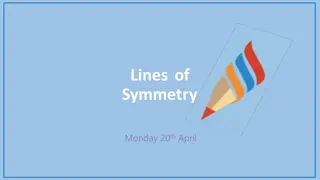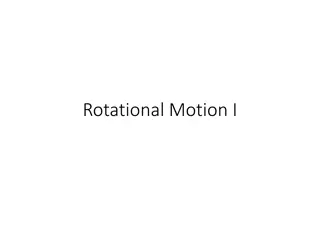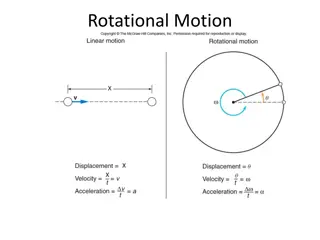Exploring Rotations and Rotational Symmetry in Geometry
Delve into the concepts of rotations, rotational symmetry, and the Windmill Method in geometry. Learn about different types of rotations, how to rotate points around the origin, practice rotations with given points, and understand rotational symmetry in objects. Discover the principles of rotating objects at various angles and the order of rotations for symmetrical outcomes.
Download Presentation

Please find below an Image/Link to download the presentation.
The content on the website is provided AS IS for your information and personal use only. It may not be sold, licensed, or shared on other websites without obtaining consent from the author. Download presentation by click this link. If you encounter any issues during the download, it is possible that the publisher has removed the file from their server.
E N D
Presentation Transcript
SECTION 7.6 ROTATIONS AND ROTATIONAL SYMMETRY
ROTATIONS 12 11 1 There are two types of rotations: CW Clockwise 10 2 CW CCW 3 9 4 CCW Counter Clockwise 8 5 7 6 Objects are usually rotated around the following angles: 90, 180, 270 0 36 Quarter Circle: Half Circle: 3 Quarters Circle 270 90 Full Circle: 180
WINDMILL METHOD: When asked to rotate a point about the origin by 90, 180, or 270 degrees create a windmill using the X and Y axis ie: rotate the point (3,4) about the origin by 90 , 180 , & 270 cw With the windmill, we can find the coordinates of the point after the rotation y 5 4 ( ) 4,3 3 2 1 x -5 -4 -3 -2 -1 0 1 2 3 4 5 -1 -2 ( ) -3 4,3 -4 ( ) 3, 4 -5
Practice: Given the point P(-2,4) i) Rotate it 90 ccw about the origin ii) Rotate it 180 ccw about the point (1,1) y y 5 5 4 4 3 3 2 2 1 1 x x -5 -4 -3 -2 -1 0 1 2 3 4 5 -5 -4 -3 -2 -1 0 1 2 3 4 5 -1 -1 ( ) -2 -2 4, 2 ( ) 4, 2 -3 -3 -4 -4 -5 -5
EX: GIVENTHEFOLLOWING OBJECT, ROTATEIT 90 (CW) ABOUT THEORIGINANDFINDTHECOORDINATESOFTHEVERTICES: y When the object is rotated 90 , objects pointing up will point to the right 5 B A 4 3 After you rotate the object find the coordinates of each vertex 2 1 C ' A x ( ( ) ' ' ' A B C -5 -4 -3 -2 -1 0 1 2 3 4 5 4,0 -1 ) 4, 2 ( 0, 2 -2 ' C ' B ) -3 -4 -5
PRACTICE: GIVENTHEFOLLOWINGOBJECTS, FINDTHE COORDINATESOFTHEVERTEXAFTEREACHROTATION: 180 degree CW rotation about the origin 90 degree CCW rotation about point I ( ) ' G 0,6 y y B 5 5 ' B ( A B 4 4 ) 2,4 G 3 3 I 2 2 1 1 C x x -5 -4 -3 -2 -1 0 1 2 3 4 5 -5 -4 -3 -2 -1 0 1 2 3 4 5 -1 -1 -2 -2 -3 -3 ' B ) ' A( -4 ( 0, 4 -4 ) 2, 4 -5 -5
ROTATIONAL SYMMETRY Objects can be rotated such that it will look the same A square has rotational symmetry because you can rotate it 90 degrees and look the same Order of rotation: How many different angles it can be rotated so that it looks the same Angles need to be less than or equal to 360 degrees Q: How many order of rotations does a square have? 4 order of operation 90 degrees 180 degrees 270 degrees 360 degrees
EX: WHICHOFTHEFOLLOWINGHAVEROTATIONAL SYMMETRY? IF YES, INDICATETHEORDEROFROTATION: 5 order of operation 2 order of operation 3 order of operation 7 order of operation 4 order of operation 1 order of operation
HOMEWORK: P366 # 4 6, 8 10, 13 14























